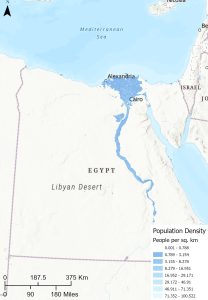24 North Africa & the Middle East: Population Geography II – Uncrowded Places
What causes geographic locations to be uncrowded or in terms of statistics to have a low population density? Clearly, these types of locations display conditions that are hazardous to human health.
Some places feature extreme cold that can be life threatening, but also limits or eliminates plant-based agriculture. Far northern latitudes such as in Siberia or Canada have low population densities for these reasons. Reindeer herds may be the source of food.
Other locations feature high mountains. These too may have very cold temperatures, while the slopes will limit plant-based agriculture. Nomadic herding may move up and down slopes with changing seasons. Slopes also are inhospitable for the construction of large settlements.

Photo by Parker Hilton on Unsplash.
Of course, for North Africa and the Middle East (NAME), the physical constraint on population is the desert. The shortage of water in the desert limits the ability of the landscape to support human population. Water itself is essential for the human body, but additionally water is needed for plant-based agriculture and for animal husbandry. Furthermore, most desert locations in NAME feature hot temperatures as they are within or near tropical latitudes. Extreme heat certainly may limit population size, but usually can be managed if water is plentiful.
Statistically, it is easier to be uncrowded by having a large landmass. A small population in a very small country is not uncrowded. A modest population in a large area may be uncrowded. Therefore and overall, places most likely to have low population densities and be uncrowded are large areas that feature extreme landscapes (one or more of extreme levels of cold, heat, dryness, elevation, and slope).
Additionally, the geographic element of access may be important. Landlocked countries tend to feature lower population densities, as they have no ports to promote trade that draws human presence and that tends to increase wealth. Areas that are remote and difficult to contact to transportation routes also will draw few people.
So, how uncrowded is NAME? The country with the world’s lowest population density is Mongolia. With somewhat high elevations and the Gobi Desert in a large landlocked area, Mongolia has several characteristics on our uncrowded list. It may resemble some locations in NAME, but of course it is not in NAME.
Essentially tied with Mongolia is the disputed territory of Western Sahara. In NAME, but also in territorial dispute with Morocco, this region is (even by name) within the Sahara Desert. It is reasonably large with square miles equivalent to those of Colorado. Both Mongolia and Western Sahara average two people per square mile. In rough comparison, a square mile measures about twenty city blocks. If you can visualize this, consider twenty city blocks, thinking that there are only two people within all the buildings, stores, apartments, homes, parking lots, and so on. That may provide perspective on this low population density. Of course, for most of these very uncrowded areas like this, there will be no buildings, stores, apartments, homes, parking lots; instead, there will be empty spaces.
Just as NAME does not hold all of the possible characteristics for creating uncrowded spaces, the region does not contain all the uncrowded countries of the world. Iceland, Australia, Namibia, Canada, and Botswana are among the top ten least crowded countries.* Nevertheless, Mauritania and Libya also are in this top ten.
Perhaps surprisingly, countries of NAME do not dominate the list of low population density countries. Given the dominance of desert regions in NAME, it would seem that almost uniformly these countries would be highly uncrowded. Ironically the reason for this disconnect is water. Countries with rivers pack lots of people along these streams. This is especially true along the Nile River in Egypt, where nearly the total population of the country lives within several miles of the Nile. Additionally, recall that when we introduced NAME as a region, we stated that S is for seaside. Within North Africa, only the countries of Chad, Sudan, and Mali are landlocked, though Sudan compensates by having the Nile River. In the Middle East, every country has coastal access, though for Jordan and Iraq these coastal stretches are very short. Coastlines promote urban development.
Wealth promotes urban development as well, partly connected to trade and partly to well-being. The oil states of NAME feature deserts but also generate income for workers and for business expansion. Urban areas have increased in oil states.
Thus, we have a split within NAME over population density. While there certainly are large tracts of desert lands that are very uncrowded, measured by very low population densities; instead, these countries often have sufficient urban populations to balance the overall population densities.
NAME countries with small land areas may even be densely populated. Not counting city-states (Singapore) or territories within a country (Gibraltar as a British Overseas Territory), Bahrain is the world’s most crowded country with nearly 5000 people per square mile. After Bangladesh at #2, Lebanon is #3 with about 1700 people per square mile.

Is NAME uncrowded? Yes, in the inland desert areas of large countries in the region, there will be very low population densities. However, in small countries and in coastal urban areas, population densities will be high, thereby balancing the number for countries overall.
*In listing the most uncrowded countries, we are not including territorial sections of countries. For instance, Greenland is the most uncrowded territory in the world, but it is a semi-autonomous region of Denmark.
Did you know?
The territory of Palestine within the country of Israel has a population density of over 2000 people per square mile.
If factoring the list to restrict it only to countries of at least eight million people, then Israel is the sixth densest country in the world with more than 1100 people per square mile.
My Turn!
CITED AND ADDITIONAL BIBLIOGRAPHY:
“Countries With the Lowest Population Density.” WorldAtlas, 29 Oct. 2018, https://www.worldatlas.com/articles/countries-with-the-lowest-population-density.html.
Jagielo, Wesley. Population Density in Egypt. College of DuPage GIS Class. May 2022.



